Stink bugs are versatile insects. Their range of species spans across the globe, making them one of the world’s most common insects. These bugs can demolish insect pests and destroy many farmers’ agricultural endeavors. You can also use them as a biological control to protect from crop predators.
We include everything you need to know in this article. That encompasses fun facts and short bios on all kinds of stink bug species.
Types and Classification of Stink Bugs
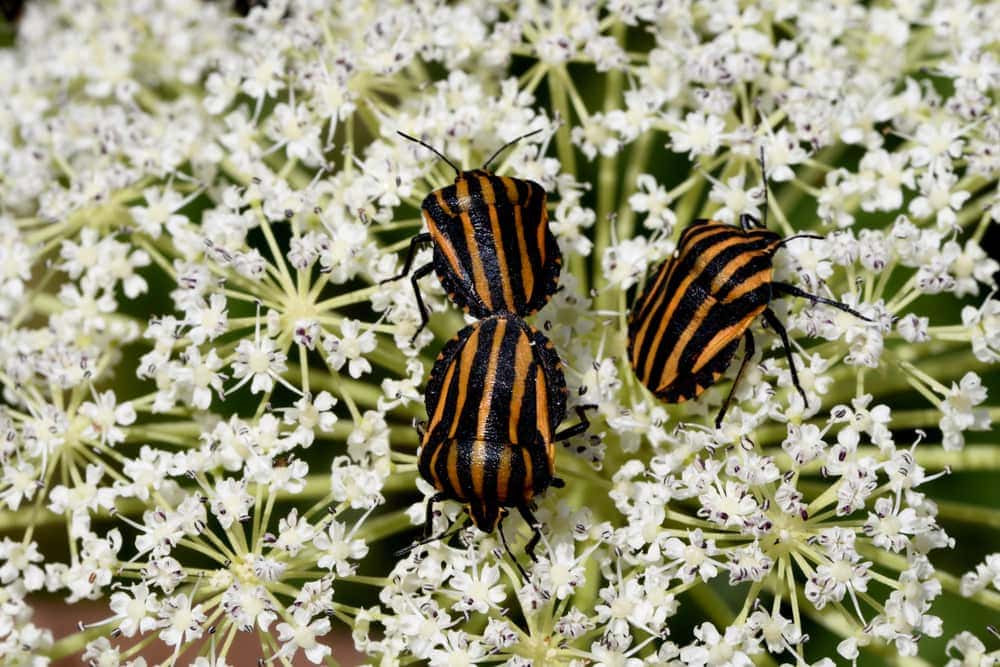
It’s useful to understand how scientists classify stink bugs. Almost all insects fall under the order Hemiptera. Stink bugs break into one of the largest superfamilies of insects, Pentatomoidea.
The Pentatomoidea superfamily contains more than 7000 species. All get divided up into 21 families. These aren’t all stink bugs, but the insects do share similar traits. The insects in Pentatomidae all have sucking mouthparts arranged in a similar way.
They use sucking mouthparts to siphon out the liquid and nutrients inside plants. These mouthparts make the Pentatomoidea family some of the world’s worst agricultural pests. That includes stink bugs.
Stink bugs are further separated from the Pentatomoidea superfamily into ten primary subfamilies. Some of these subfamilies include many species of world-renowned stink bugs. Others have only one or two species concentrated in specific areas.
In British English, it’s more common to call stink bugs “shield bugs.” This name comes from the rigid exoskeleton. It seems to be in the shape of a medieval shield across their backs.
The American moniker “stink bug” veers away from their visual appearance. It’s more about their nasal effect. They can release a strong-smelling spray as a defense against birds or other insects. If you want more information on their smell, scroll down to see “Fun Facts About Stink Bugs” at the end of the article.
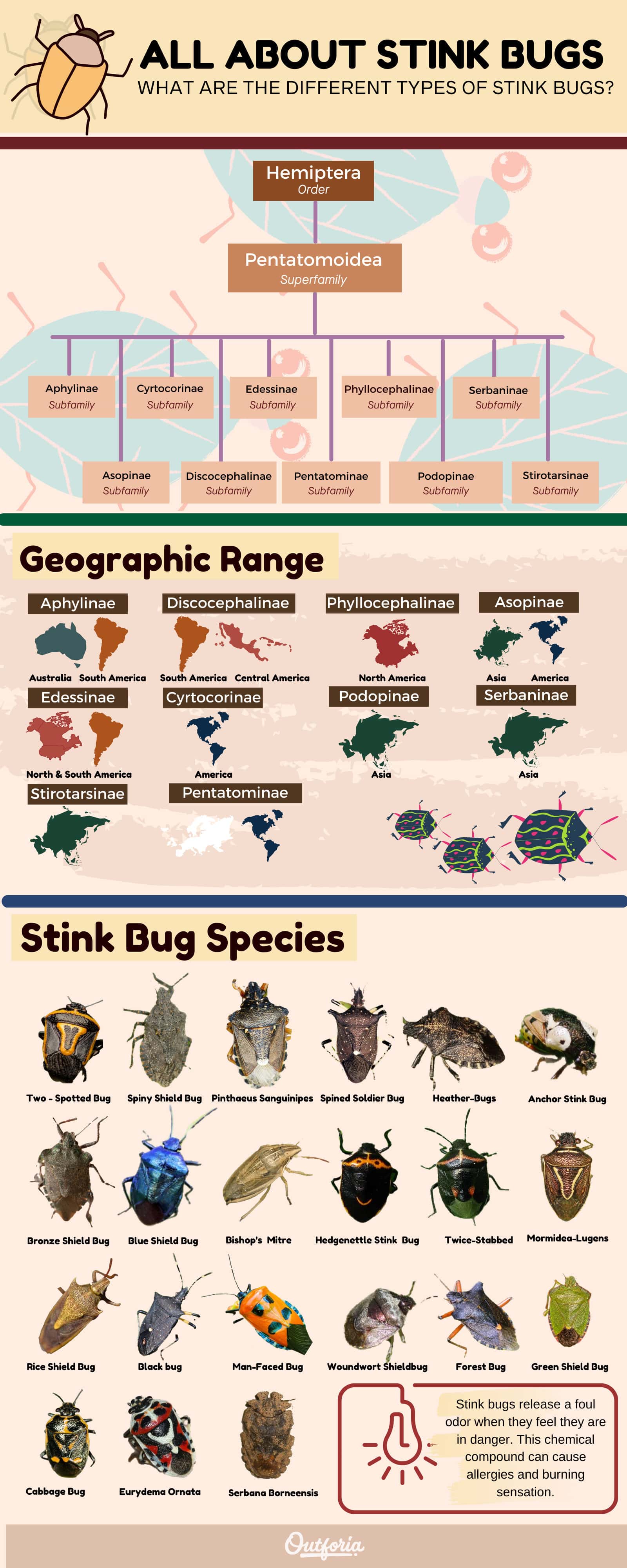
Share this Image On Your Site
<a href="https://outforia.com/types-of-stink-bugs/"><img style="width:100%;" src="https://outforia.com/wp-content/uploads/2021/04/Stink-Bug-Infographic.jpg"></a><br>Stink bugs Infographic by <a href="https://outforia.com">Outforia</a>You May Also Like: Discover These 18 Different Types of Wasps with Guide, Photos, Infographics, and more!
Stink Bug Subfamilies
1.0 Aphylinae
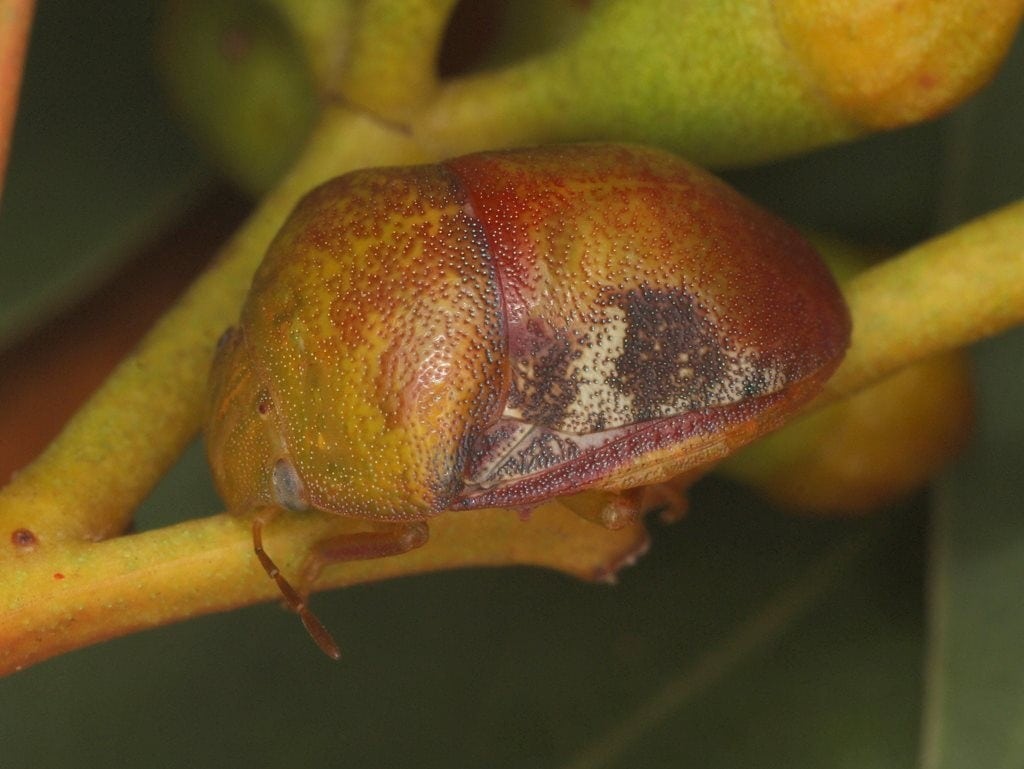
There is very little known about the few Aphylinae stink bugs that belong. Researchers have found small populations in Australia and some parts of South America. Because of this, they were only found and classified recently.
There are two genera of Aphylinae stink bugs. They include the Aphylum and the Neoaphylum. There is only one species in the Neoaphylum genera, including the Neoaphylum grossi. Scientists found them in Ecuador. They discovered and classified them in 2001.
There are two species within the genus Aphylum. These include the Aphylum bergrothi and the Aphylum syntheticum. They’re both found in Australia. The sighting and first classification of the Aphylum bergrothi were in 1906. Since then, there have not been other recorded sightings.
There has been one other sighting of the Aphylym syntheticum. The picture above is of this little stink bug.
2.0 Asopinae
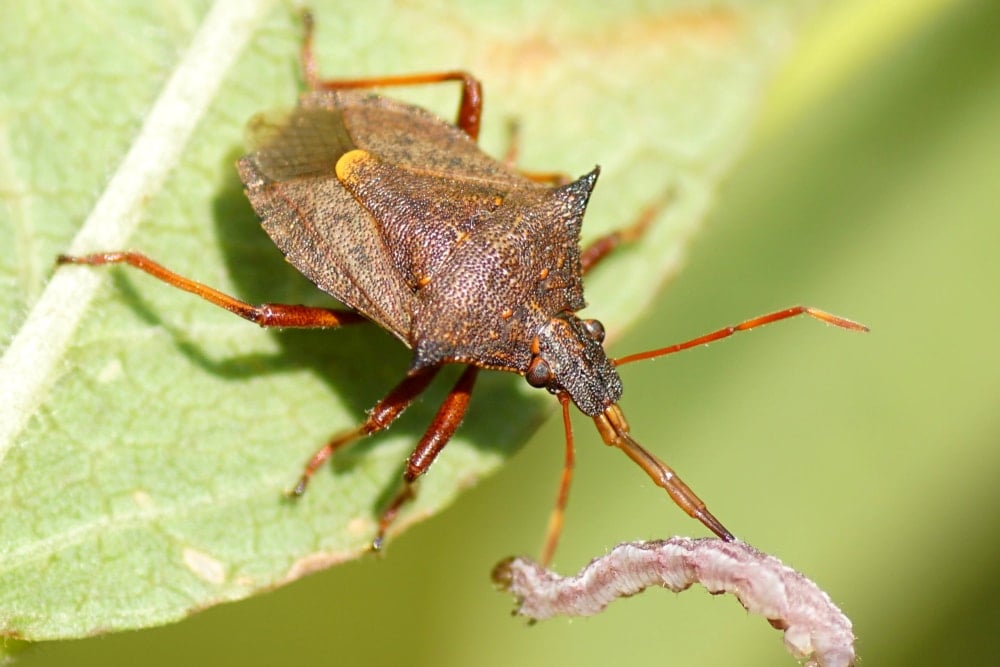
Asopinae stink bugs are one of the more common among the stink bug families. Many genera fall under this heading and even more species. Luckily, many of these species are predatory stink bugs. That means that instead of sucking the life out of plants, they kill other pests that attack crops.
The Asopinae are often used as biological control agents. They’re effective against all kinds of crop pests. That includes the dangerous Pentatomids. The Pentatomids contain some of the most destructive agricultural pests worldwide. We cover that in more detail later.
2.1 Andrallus
2.1.1 Andrallus spinidens
The Andrallus spinidens stink bug is a predatory member of the Asopinae subfamily. They’re natural enemies to many types of harmful insects.
They will attack members of the species at almost any of their life stages. They seem to prefer to hunt larvae, but farmers can release them to eat almost any stage of harmful bugs. Some of their common enemies include the Rice Leaf Folder (Cnaphalocrocis medinalis) and the Purple Stem Borer (Sesamia inferens).
The A. spinidens live throughout central America, most often found in Mexico. Some species have been located in Southern California, but that is quite rare.
Otherwise, the insect lives throughout Southern Asia. Their range extends throughout China, India, Malaysia, and the islands of Indonesia. They like to feed on those bugs that attack rice fields. That preference makes them desirable insects throughout Asia.
2.2 Apateticus
Under the genus Apateticus, there are about seven described species. Most of these aren’t very common since scientists haven’t found them again since their discovery in the 1800s. Only one of the species is better known to the modern world. All species under this genus are predatory stink bugs.
2.2.1 Apateticus lineolatus
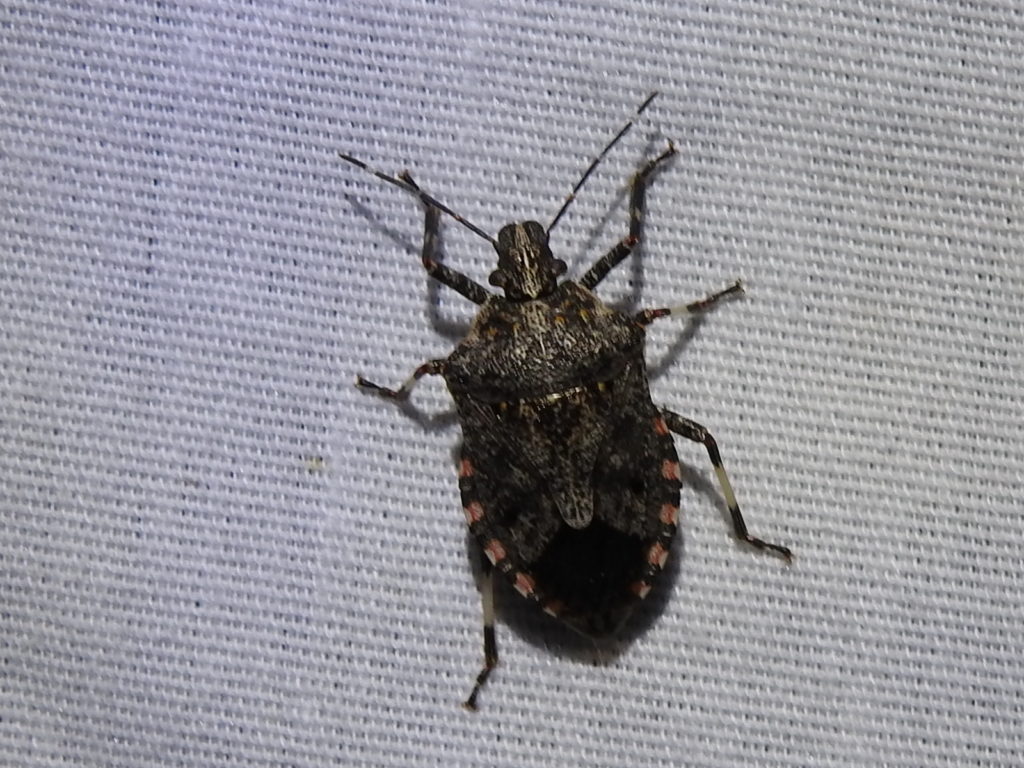
The Apateticus lineolatus lives in Central and South America. They live in Mexico, Puerto Rico, and a few have been recorded in Texas. These insects are predatory for the most part. Researchers have only recorded them as a natural enemy of the Colorado Potato Beetle (Leptinotarsa decemlineata).
The Colorado Potato Beetle is a devastating bug to agricultural crops. The A. lineolatus targets them in their larval stage.
2.3 Cazira
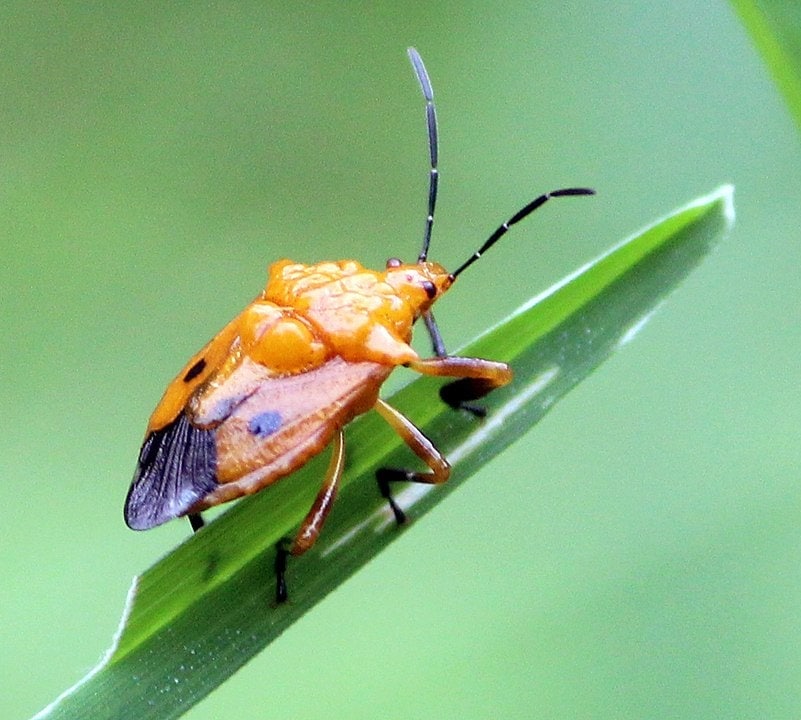
The Cazira genus contains stink bugs found in the Indo-Malayan region for the most part. These bugs have antennae with five joints connecting to a basal segment at the top of their head.
A scutellum is a piece of exoskeleton right behind the head. This genus has inflated tuberculations around it. This makes them a bit easier to identify.
There are currently fifteen species classified under the Cazira genus. None of these are well-known. Each with very little information on them.
The primary reason for this comes down to their location. They live in remote sections of India, China, and Japan. Explorers discovered many species in the late 1800s and early 1900s. There have been few recorded sightings since then.
2.4 Euthyrhynchus
2.4.1 Florida Predatory Stink Bug (Euthyrhynchus floridanus)
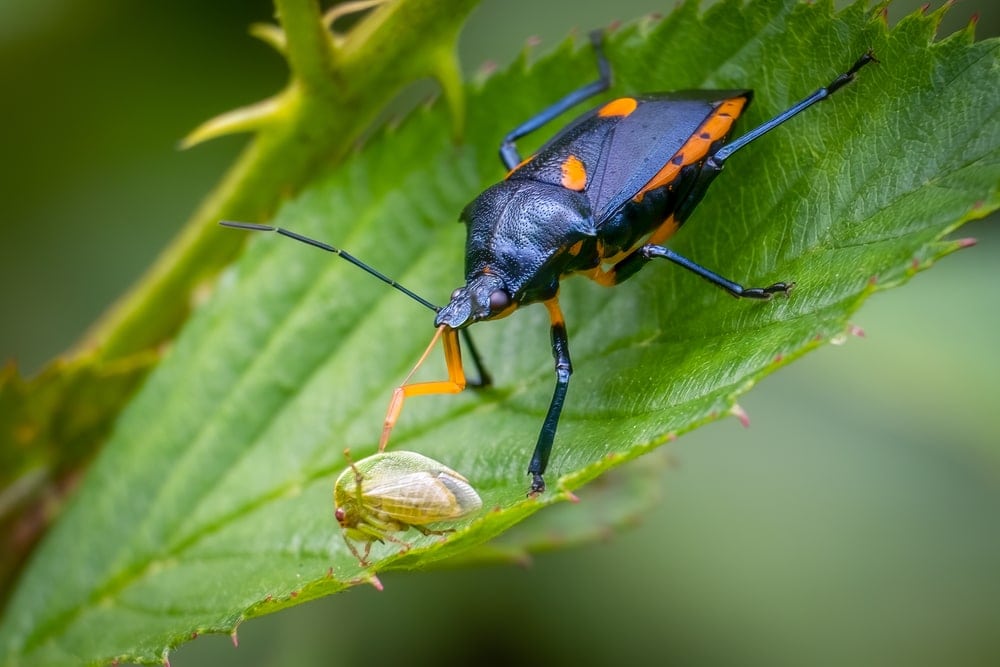
The Florida predatory stink bug is the only Euthyrhynchus species of stink bug. They’re native to Florida and other states in the Southeast of the US. They make their home in the hottest parts of the country, preferring to be warm all year round for survival.
As their name suggests, the Florida Predatory Stink Bug is a carnivorous Pentatomid. They feed on all kinds of pest insects. That includes things like grasshoppers and larval stages of many other insects. An interesting fact about this Floridian stink bug is that it prefers to hunt in a pack. Each pack includes at least 12 insects.
You can identify this stink bug by its blue-black coloration and two wide red spots on the rear of its scutellum. They have a distinctive spine with a long beak-like mouthpart. It contrasts the sap-sucking mouthparts of their Pentatomidae relatives.
These stink bugs lay batches of 20 to 90 eggs in large nests. These take at least 35 days to hatch and another 65 days for nymphal development.
2.5 Oplomus
The Oplomus genus is another predatory stink bug belonging to the family Pentatomidae. Nine species fall under the genus. Many of these are unknown or live in remote parts of the world. Their location has kept them from getting extensive study.
2.5.1 Oplomus dichrous
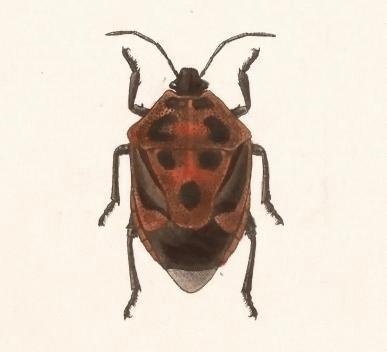
The Oplomus dichrous is a greedy little stink bug. Scientists generally find them in Central and North America. They‘ve received in-depth study since they control the devastating Colorado Potato Beetle.
A study was done by the Entomological Society of America. In it, they found that in cold temperatures, they were almost ineffective. When they reached hot summer temperatures, they performed very well. They cannot overwinter further North than Colorado. That limits the amount of good they can do as a biological predator in North America.
2.5.2 Oplomus mundus
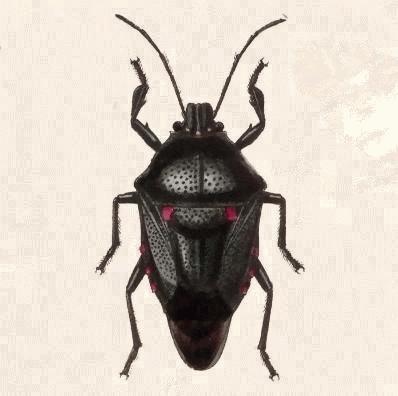
The Oplomus mundus is a predatory stink bug that lives within Central and North America. They do not overwinter in cold temperatures and must live where it remains hot year-round. The farthest north they have been recorded is in Brownsville, Texas.
2.6 Perillus
The Perillus genus has seven species of stinkbug. Only one of them is a standard or well-known bug. Many others only got recorded a few times and only in remote regions of Central America.
2.6.1 Two-Spotted Stink Bug (Perillus bioculatus)
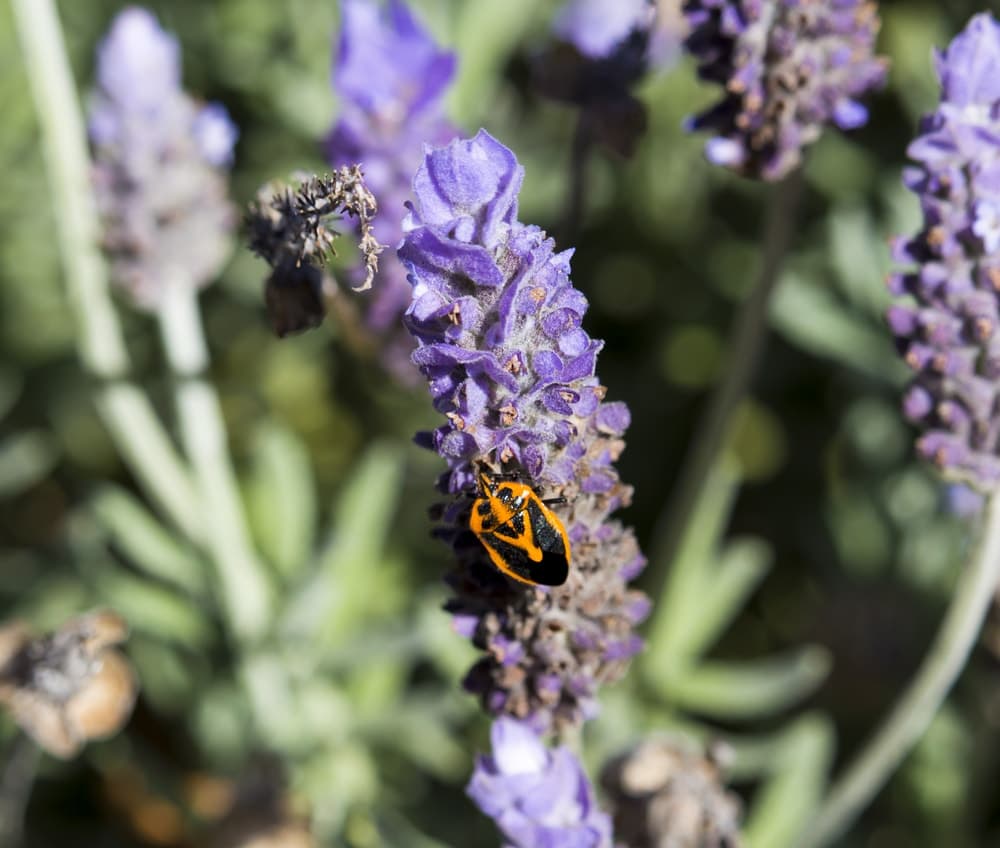
The Two-Spotted Stink bug is also called the Double-Eyed Soldier Bug. They’re native to North America. Both of their life stages, larval and adult, are predators of the Colorado Potato Beetle. Unfortunately, the first instar of the stink bug larvae survives by sucking the juices from potato stems. That limits their benefit as biological controls.
The adult version of this bug has a distinctive coloration and shape. They’re shield-shaped like most other stink bugs. They’re black with bright yellow and red spots along the edge of their shell and their abdomen.
You can most often find them in their adult and nymph stage foraging on plants. This stink bug is also able to overwinter and is common throughout all North America.
2.7 Picromerus
The Picromerus genus has 11 stink bugs. Again, only one of these is well-known. It was also one of the earlier stink bugs that got classified. Carolus Linnaeus, the original creator of the modern classification system, was the one who classed them in 1758.
2.7.1 Spiny Shieldbug (Picromerus bidens)
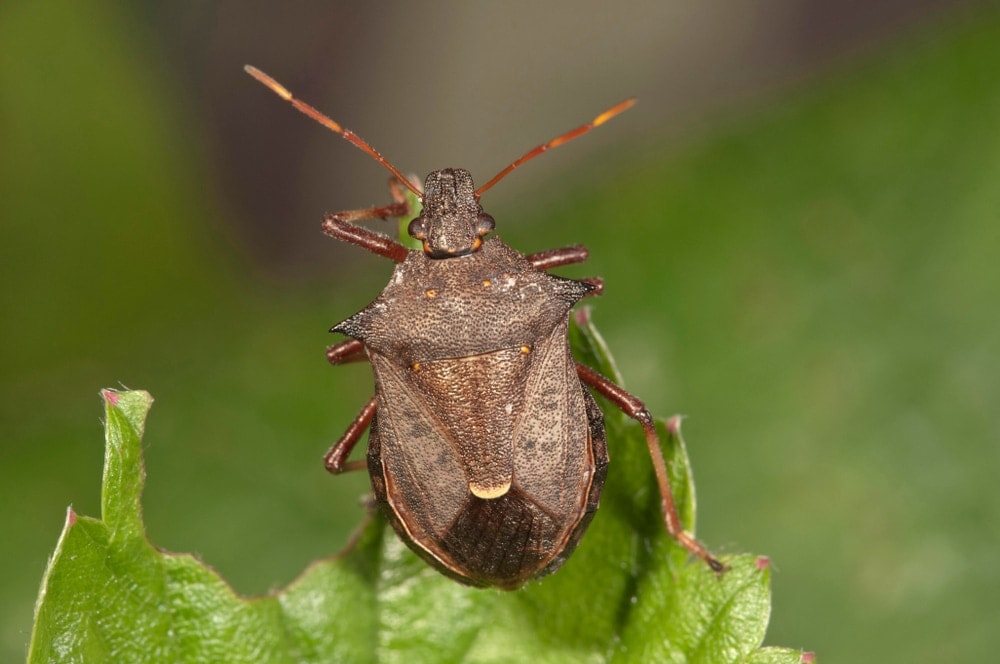
The Spiny Shieldbug is a member of the carnivorous genus of Picromenerus. They have a global distribution and are one of the more common stinkbugs around the world. They live from North Africa to the British Isles, extending over to China. These bugs came to North America by accident in recent years. Now there have been more than 180 sightings of them.
Identifying the Spiny Shieldbug isn’t as easy as it’s with other species. They have a variable body color, from brown to blue or even reddish. They also change between nymph instars, making it even more difficult.
These bugs prefer to feed on the larvae of other insects. That includes caterpillars, aphids, and beetles. Unfortunately, both nymphs and adults also suck sap from plants.
2.8 Pinthaeus
Within the Pinthaeus genus, there are only one species of stink bug. They’re yet another member that eats other insects. That includes pests and pollinators alike.
2.8.1 Pinthaeus sanguinipes
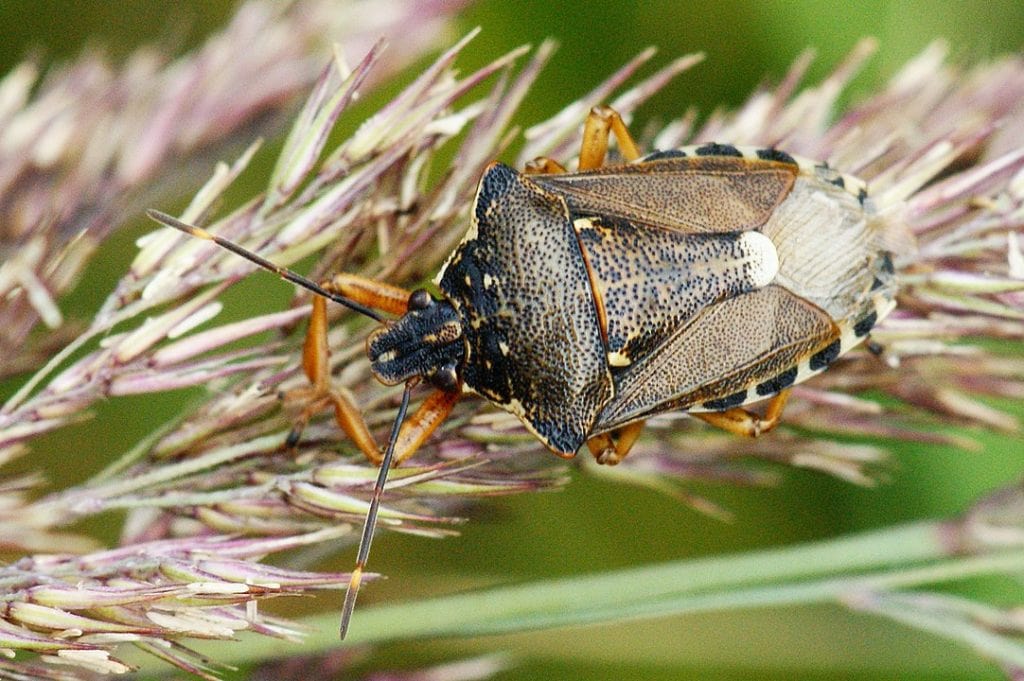
The P. sanguinipes have distinctive red legs. They have a black and white spotted rim on their hard exoskeleton’s outside edge. They feed on larvae of beetles, butterflies, and sawflies. More than anything, they prefer the larvae of the Pale Tussock moth.
The P. sanguinipes live throughout most of Europe. They‘re somewhat rare. Your best chance of finding one will be at the edges of deciduous forests.
2.9 Podisus
The Podisus genera is a larger genus of stink bugs. At least 20 species fall under the Podisus genera. Several of these are pretty familiar. These stink bugs also tend to be more colorful. Their shells display stripes and all sorts of strange patterns.
2.9.1 Spined Soldier Bug (Podisus maculiventris)
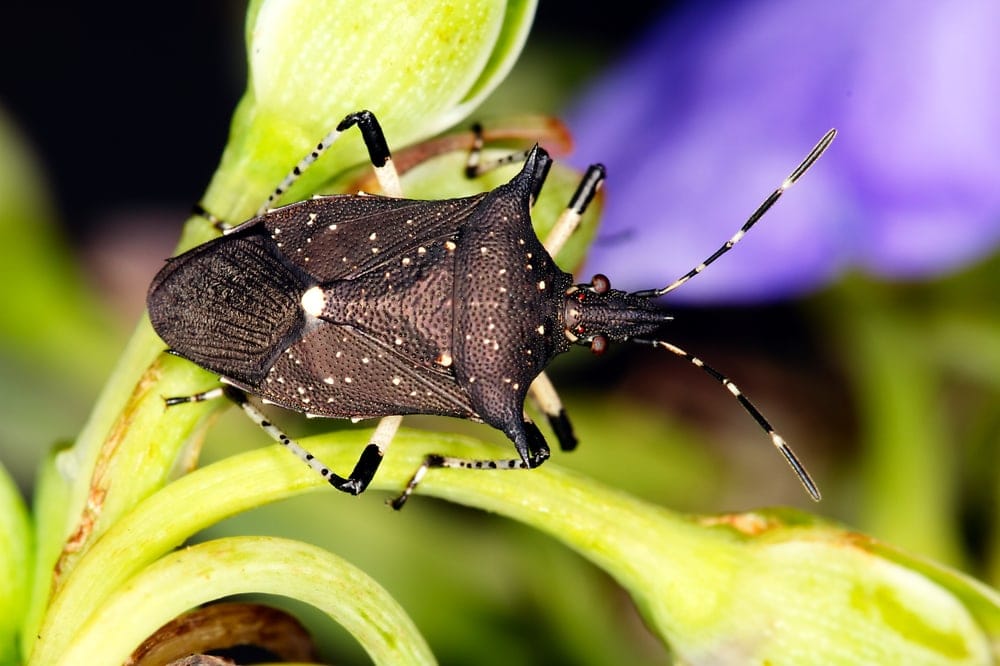
The Spined Soldier Bug is one of the most common varieties of stink bugs living in North America. They’re predator insects, prey on caterpillars of the gypsy moth, and larvae of many beetles. Some of these beetle species encompass notorious pests. They include the Mexican Bean Beetle and the Colorado Potato Beetle.
The Spined Soldier Bug does feed on some plant juices. The recordings of this show them as incapable of causing significant harm. Instead, their generalist predatory habits maintain their status as welcome garden guests.
2.9.2 Podisus placidus
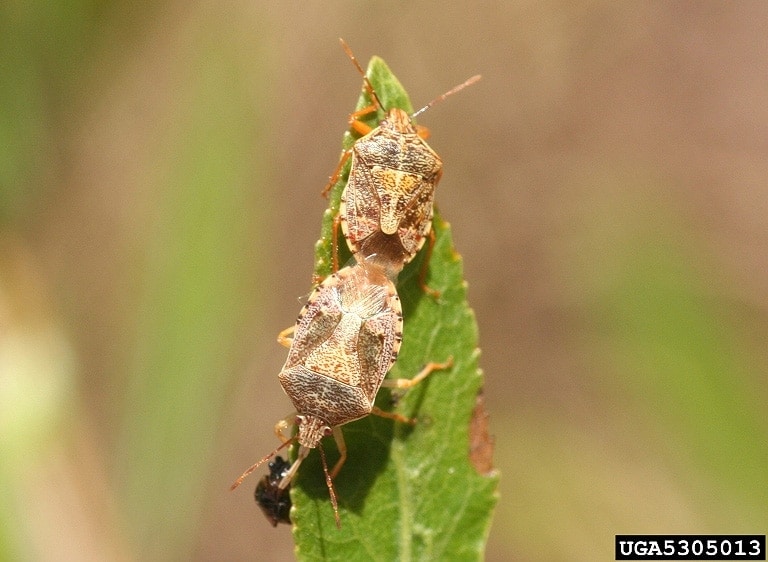
The Podisus placidus is a close cousin of the Spined Soldier Bug. They feed on many of the same insects and have a similar geographical spread. These bugs live in North America, spreading across the United States and parts of Canada. You can also find them in Yugoslavia and Serbia.
2.10 Rhacognathus
The Rhacognathus is a genus of predatory stink bugs. They got discovered early on in classifying the Hemiptera order. There are only four species associated with this genus. Several of them might be extinct since there have been no sightings for many years.
2.10.1 Rhacognathus americanus
The R. americanus is an exciting insect among all the thousands of stink bugs. They’re a predatory bug, or at least they were. Many scientists believe them to be extinct at this point, for unknown reasons.
R. americanus was first described in 1870. It was native to North America but was very rare, even at their discovery. They were dark brown with mottled yellow spots. Almost nothing is currently known about their life stages or history. People so rarely encountered them.
There are almost 40 verifiable sightings of the species throughout the 20th century, most in the Midwest. There hasn’t been another reported sighting since 1966.
2.10.2 The Heather Bug (Rhacognathus punctatus)
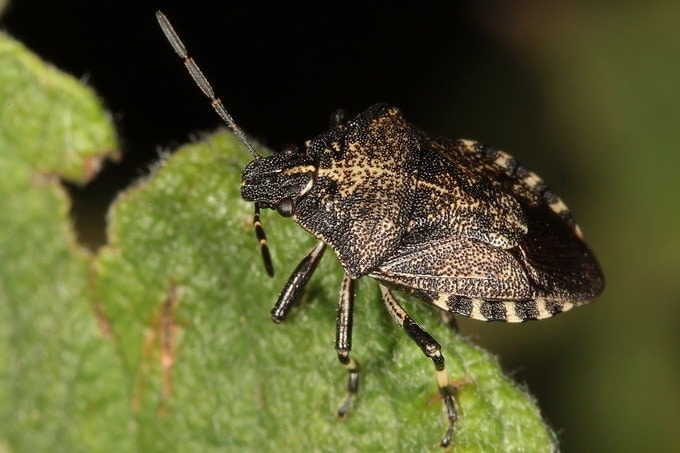
The Heather Bug is a mottled brown color with metallic bronze mixed across their shield and shoulders. They prey on the leaf beetles’ larvae, such as the Lochmaea caprea and the Lochmaea suturalis.
These shiny bugs are often found on the edges of heaths or in the moors and lowland mires. It’s typical to find them on and around is heather, hence their name. The insects live throughout most of Europe. Their adults are present all year round, feeding on irritating pests.
2.11 Stiretrus
Within the Stiretrus genus, there are six species. Out of these six, scientists have only kept track of one.
2.11.1 Anchor Stink Bug (Stiretrus anchorago)
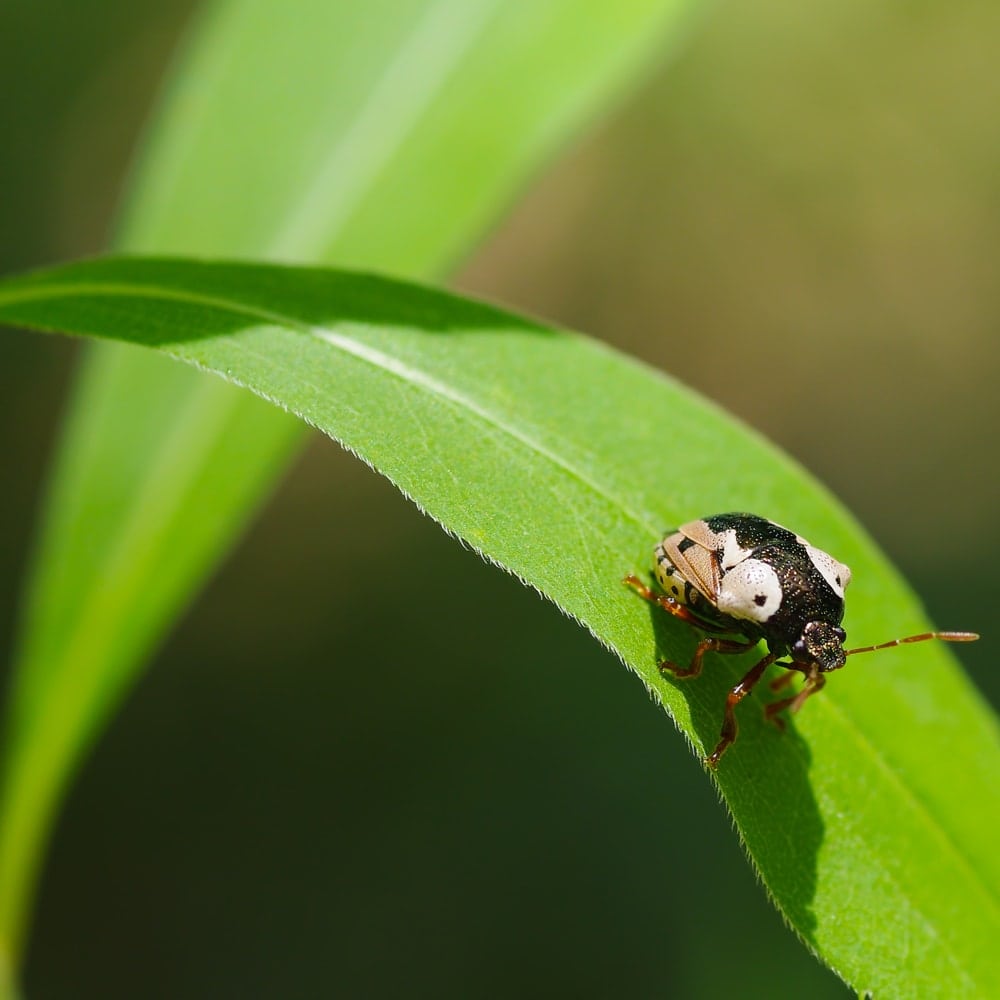
The Anchor Bug is a great predator. They’re often confused with Harlequin Cabbage Bugs, another stink bug. The Harlequin Bug is within the Pentatomidae family and an irritating agricultural pest.
Both species have shiny black exoskeletons and distinctive spotted markings. They can be orange, yellow, or red with black markings.
One of the easiest ways to determine between the two species is to look at the beak if you can get that close. The S. anchorago has a beak twice as thick as their antennae for their predatory eating habits. They’re native to most of eastern North America.
2.12 Troilus
The genus Troilus was first described in 1867 by Carl Stal. There are only two species associated with the genus. These include one that is very rare, discovered in 2011, Troilus maracaja. The more common specimen from this genus is the Troilus luridus.
2.12.1 Bronze Shieldbug (Troilus luridus)
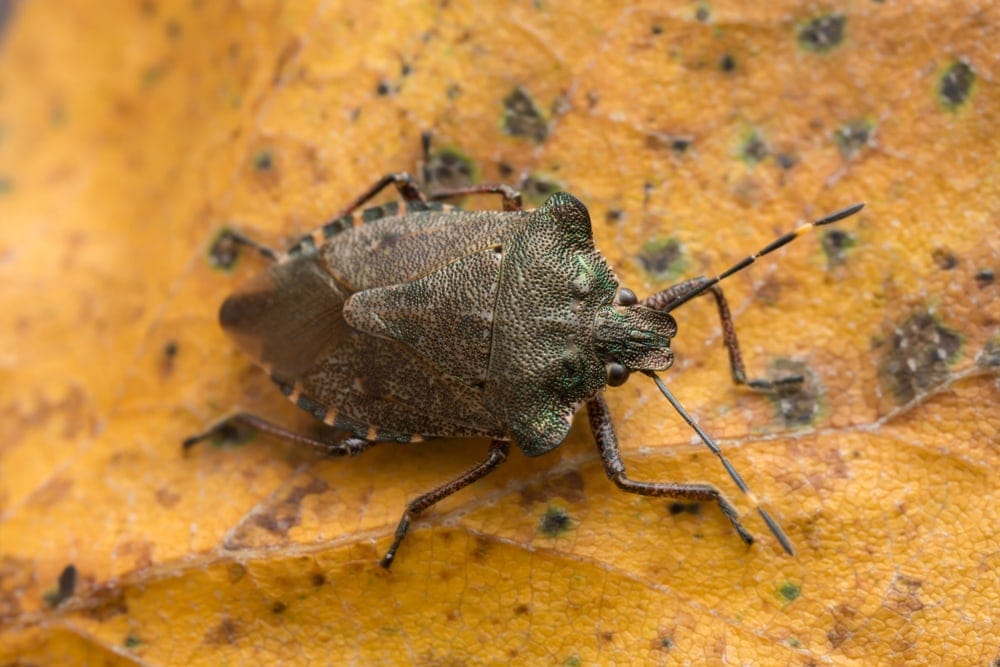
The Bronze Shield Bug spreads all over Europe and is one of only four carnivorous stink bugs found in the UK. Researchers first described this specific species in 1775. That makes them one of the earliest stink bugs to receive any classification.
As an Asopinae member, the T. luridus is a carnivorous species. They like to eat the larvae of sawflies, moths, butterflies, and beetles. These dietary preferences make them a reasonable control against pests.
These insects are quite large. They’re bronze-brown and have an orange band on the second-to-last antennae segment. Their legs also have orange tips.
The Bronze Shield Bug is capable of overwintering and will emerge again in April to lay its eggs. Their first instar feeds on plants. Their following instars prefer a carnivorous diet.
2.13 Zicrona
The name Zicrona for this genus of stink bugs comes from a Hebrew word. The work means “odorant” in their language. It describes the malodorous stink that most of these bugs can produce. There are four species recognized as members of the Zicrona genus. Only one is common and has been since Linnaeus classified it.
2.13.1 Blue Shieldbug (Zicrona caerulea)
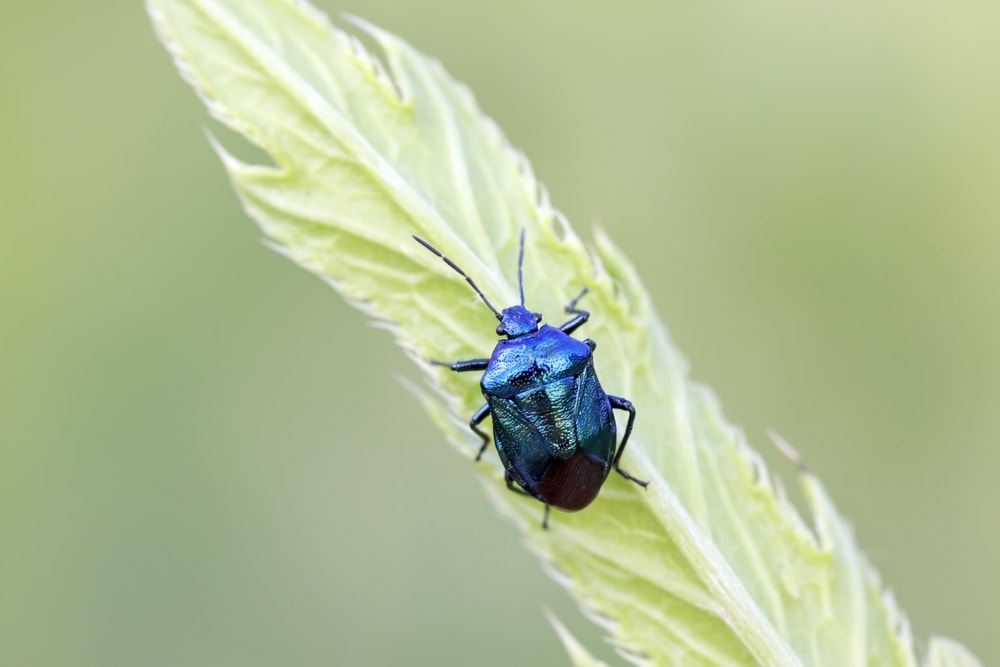
The Blue Shieldbug is a beautiful specimen of stink bugs. Their adult version looks scarab-like with their shiny blue exoskeletons. Their nymph stages feature an exoskeleton of bright red with black spots. They look like ladybugs but with much longer legs and antennae.
The Blue Shieldbug can make beneficial predators. They prey on leaf beetles within the genus Altica. They also feed on plants, but it’s more common to eat the larvae of moths and beetles. The Blue Shieldbug’s range takes it across Europe, much of Asia, and North America. They like to stick to moors, damp grasslands, and the edges of forests.
2.14 Other Genera of the Asopinae Subfamily
Beyond the 13 genera that we listed above, there are many more Asopinae species. All are predatory stink bugs.
Unfortunately, almost all these species have small populations and restricted regions. Explorers have spotted them so few times that there is very little information on them. Some of these other genera include:
- Apecilus
- Australojalla
- Brontocoris
- Canthecona
- Cecyrina
- Coryzorhaphis
- Dinorhynchus
- Friarius
- Jalla
- Leptolobus
- Marinina
- Montrouzieriellus
- Parajalla
- Supputius
Most of these genera contain lesser-known species or extinct species. If no one records them for more than one hundred years, it is difficult to research them.
3.0 Cyrtocorinae
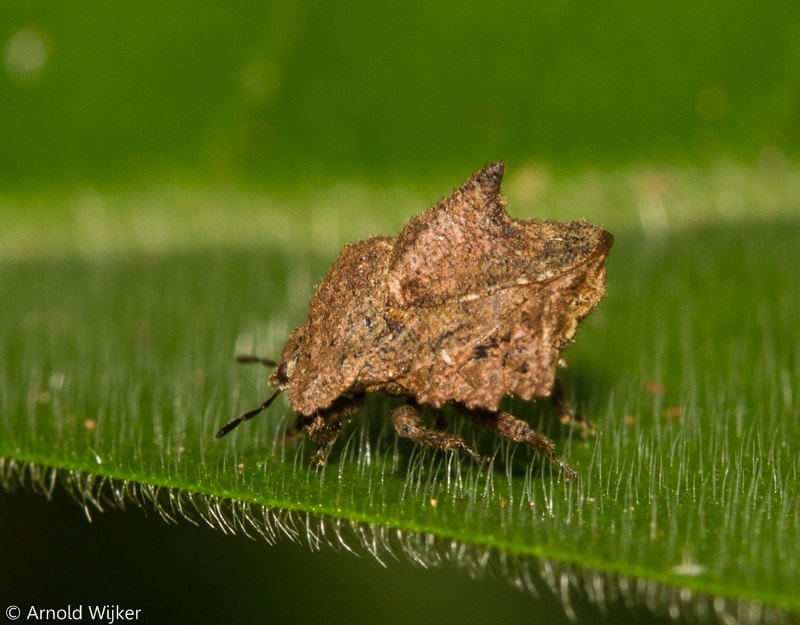
The Cyrtocorinae is one of the least-recognized stink bugs in the world. There is very little recorded about any of these species.
Cyrtocorinae stink bugs live in neotropical regions such as Central and South America and the Caribbean. Not all South America is neotropical. They live from Argentina to Mexico. Most of their species have an exoskeleton that mimics the tree bark on which they live.
4.0 Discocephalinae
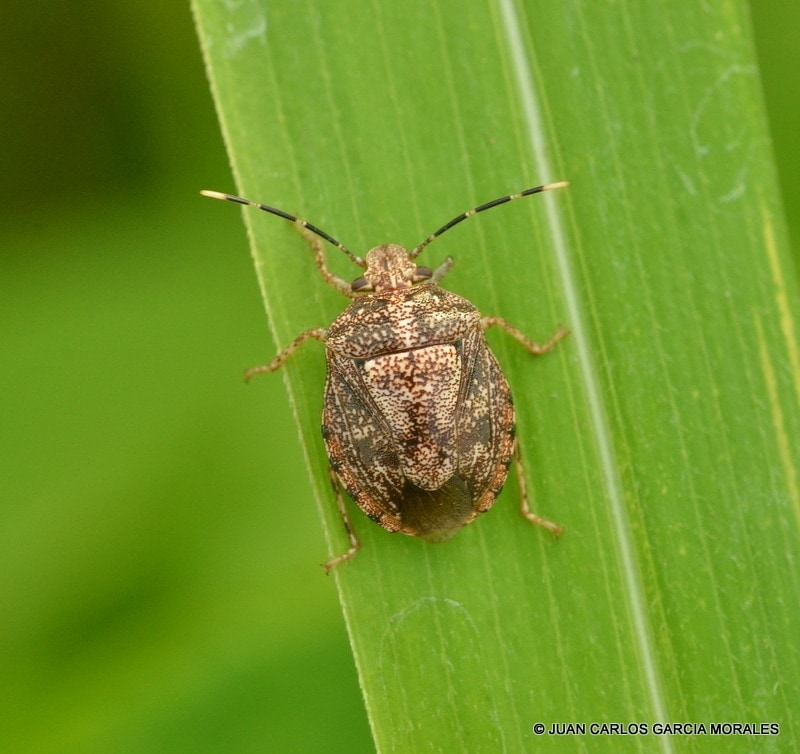
The next subfamily of stink bugs is the Discocephalinae. Discocephalinae has two tribes, the Discocephalini and the Ochlerini. Between the two tribes are more than 300 classified species. Most of them are dark-colored and medium-sized. The biology and habits of the species aren’t known for the most part.
5.0 Edessinae
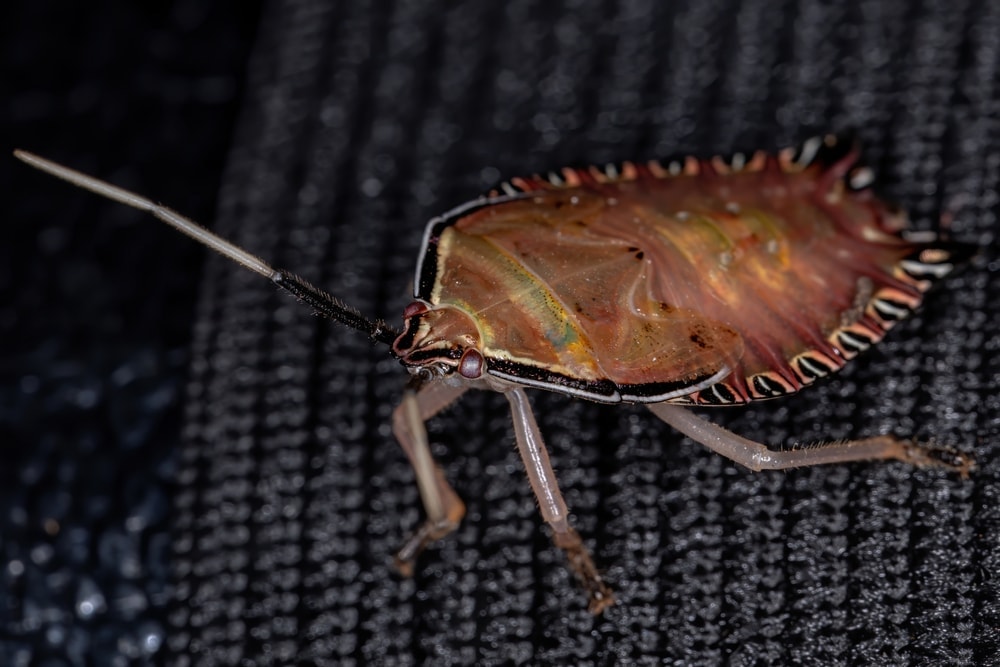
Edessinae contains approximately 300 species of stink bugs. This family consists of a wide variety of stink bugs. It has most of the largest and most colorful stink bugs. There has been very little research done on these stink bugs. They live in Central and South America and are rare. Some of the species include:
- Plagaedessa distanti
- Pladaedessa nigrovittata
- Plagaedessa maranhensis
6.0 Pentatominae
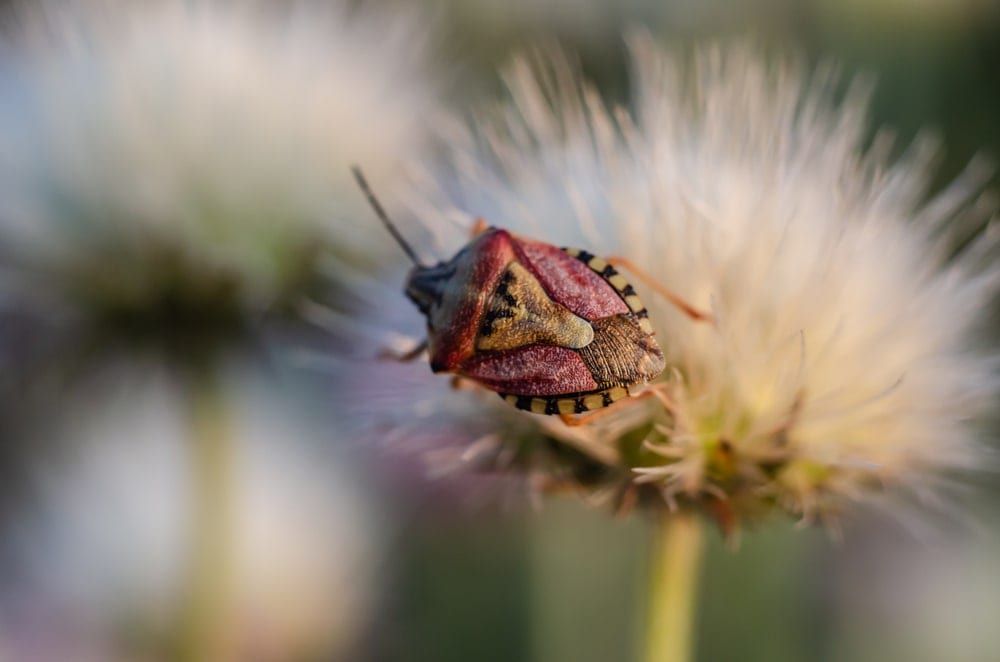
The Pentatominae subfamily is the largest within the entire Pentatomidea family. There are more than 4,937 species of these insects, broken down into 938 classifications!
If you remember, Pentatominae contains some of the world’s worst agricultural pests. It can sometimes feel as though you’re fighting a losing battle with so many different kinds of them. There are many ways to work against them.
Even being destructive, they’re pretty interesting to learn about. We’ve included some of the more common Pentatominae tribes and genera. We’ve also selected some of the most well-known species out of each of these to show you.
6.1 Aelia
Aelia is one of the genera of the shield bugs under the Pentatominae subfamily. There are 15 species belonging to the genus Aelia. Only one is more common and classified by Linnaeus.
6.1.1 Bishop’s Mitre (Aelia acuminata)
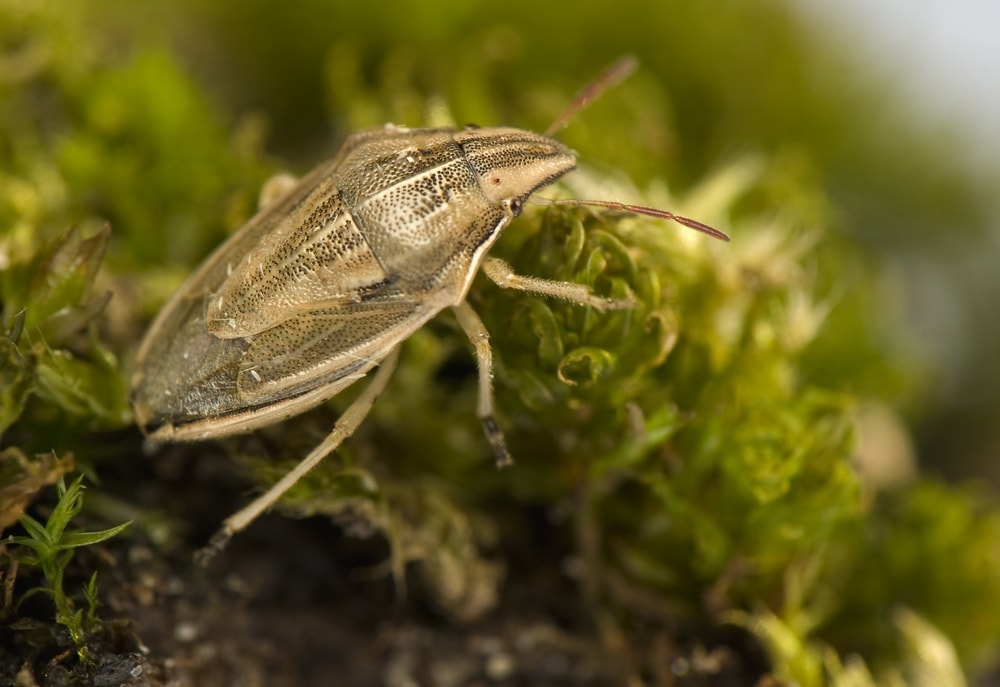
Bishop’s Mitre is a stink bug with an elongated body and a pointed head. They’re brown and tan, with distinctive stripes running down their exoskeleton. They also have red-tinged antennae. They were first classified as Cimex acuminata by Linnaeus.
The Bishop’s Mitre has a pretty strict diet. It prefers to only feed on cereal grasses belonging to the Poaceae family. They can do significant damage to fields of cereals but are otherwise harmless. This species lives high up in the Alps at approximately 4300 feet (1300 meters) above sea level.
6.2 Bathycoeliini Tribe
Within the Bathycoeliini Trib is the Bathycoelia genus of shield bugs. Researchers at North Dakota State University have listed most of these. They include more than twenty species native to West Africa. Only one of them has received significant study.
6.2.1 Bathycoelia thalassina
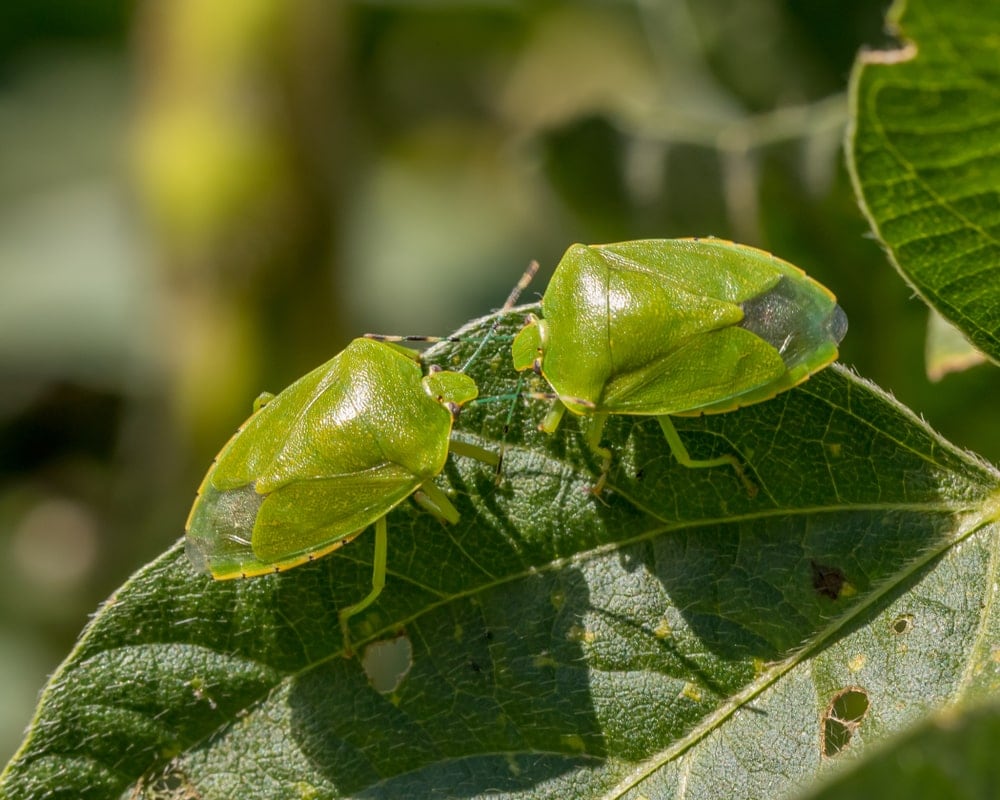
These stink bugs are pretty large and green. They have a flattened border around their abdomen. They can have a black pattern run across their underside. These stink bugs are a newer pest in West Africa. They target the cacao plantations.
Researchers have studied the B. thalassina while feeding on the developing cocoa pods. This has done extensive damage to the pods since the 1960s. Their feeding makes the bean pods appear malformed and brown. It’s pretty challenging to control these pests.
6.3 Halyomorpha
The Halyomorpha genus of stink bugs belongs to the tribe Capparoni. There are about 40 various species included in this genus. Many of these have not received any more scientific interest since they’re pretty rare. The exception in this genus is the Marmorated Stink Bug.
6.3.1 Brown Marmorated Stink Bug (Halyomorpha halys)
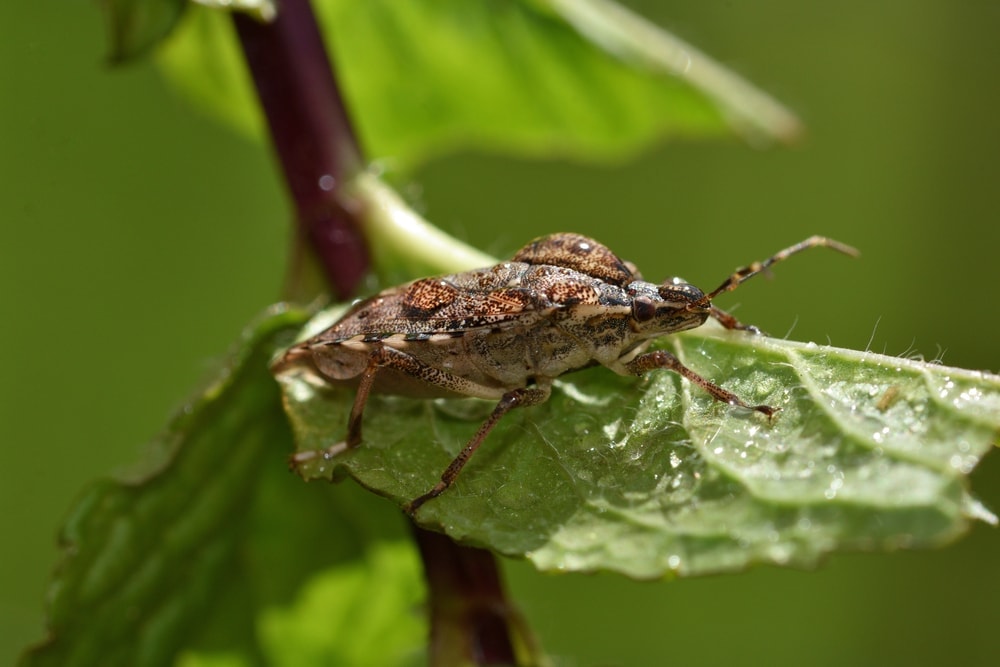
The Brown Marmorated Stink Bug is native to most of Asia, including China and Japan. They’ve also gotten to North America by accident. Farmers first saw them in Pennsylvania in 1998.
The Brown Marmorated Stink Bug is a very damaging pest for crops since they feed on over 100 plant species. In 2010 in the US alone, there was a loss of $37 million in apple crops due to these insects.
Unfortunately, this stink bug now lives in most of North America, South America, and Europe. Much is being done to curb the spread of the insect. The goal is to stop them from destroying orchards and gardens each year. Currently, we do this with biological controls and artificial pheromones for bait traps.
6.4 Carpocrini Tribe
The Carprocrini tribe of shield bugs is extensive. There are 15 genera of classified bugs. Within those genera, there are at least 50 species. Many of them have not yet received extensive study. Some of the genera include:
- Antheminia
- Cosmopepla
- Holcostethus
- Kermana
- Menecles
- Mormidea
- Oebalus
- Trichopepla
- Proxys
Among these are some exciting stink bugs. The ones we’ve listed below are those that stand out among the 50 genera. They receive more of a focus from the scientific community for their uniqueness.
6.4.1 Hedgenettle Stink Bug (Cosmopepla conspicillaris)
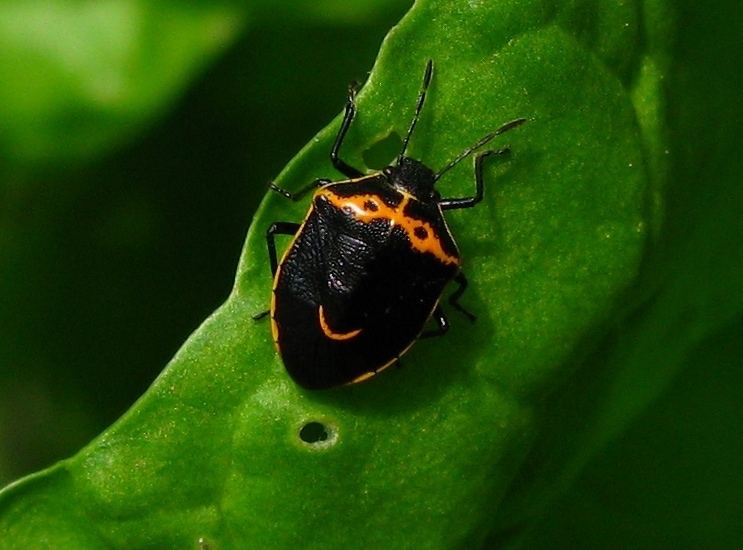
The Hedgenettle Stink Bug was first spotted and described in 1951. They have a dietary preference for plants in the Stachys genus. Other common names include the Two-Spotted Stink Bug or Happy Bespectacled Stink Bug. These names come from the interesting pattern on their exoskeleton.
These stink bugs are showy. They’re black with orange markings on their body. Across their dorsal thorax is the shape of orange spectacles. They have two black dots in the middle of an orange line. At the bottom of their scutellum is a small shape, also in orange. Since they feed on weeds instead of agricultural plants, they aren’t a threatening stink bug.
6.4.2 Twice-Stabbed Stink Bug (Cosmopepla lintneriana)
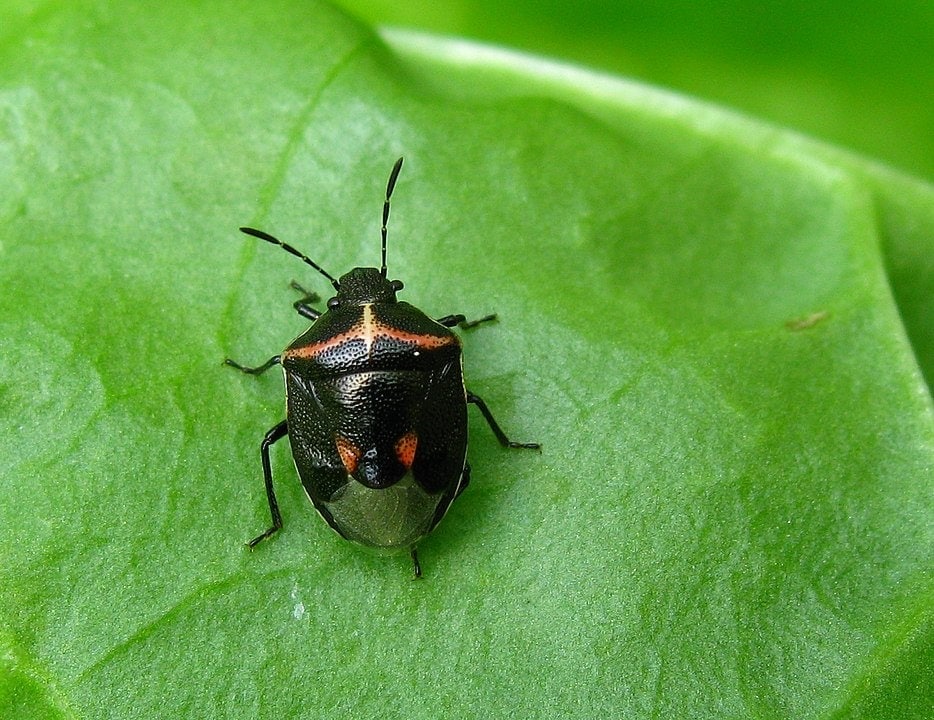
The Twice-Stabbed Stink Bug also receives its name from the spots of orange or red across a black body. At the top, they have a band of orange, and at the bottom, two spots where it seems to have gotten stabbed. These insects also feed on plants, but most of these aren’t very valuable crops.
The C. lintneriana feeds on weedy plants and some cereals. Meals they prefer include milk thistle, min, oats, asparagus, goldenrod, and echinacea. They live throughout most of North America and spread down into Mexico as well.
6.4.3 Mormidea lugens
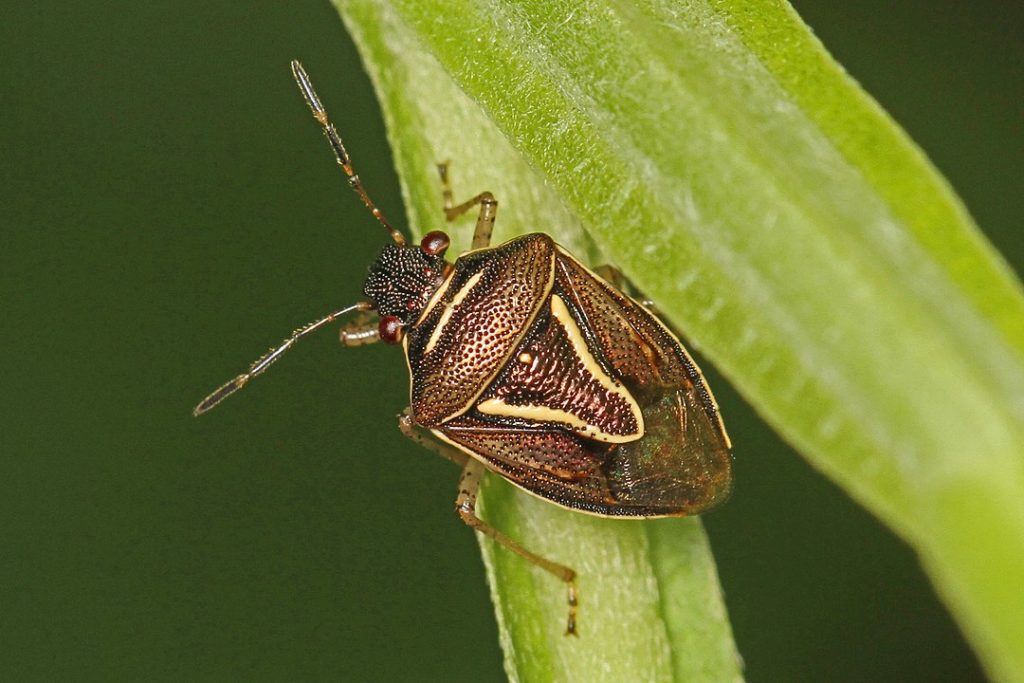
The Mormidea lugens have a wide range. They live in parts of the Caribbean, Eastern North America, and Central America. Scientists thought these pests needed a warmer climate. Now they know they can overwinter in Illinois. They feed on a wide variety of plants having a particular soft spot for grasses.
Some of the plants these bugs prefer are Timothy sedges, Deer-tongue grass, and Pale sedge. Most of these aren’t valuable crops. They do still irritate grass and wildland development.
6.4.4 Rice Stink Bug (Oebalus pugnax)
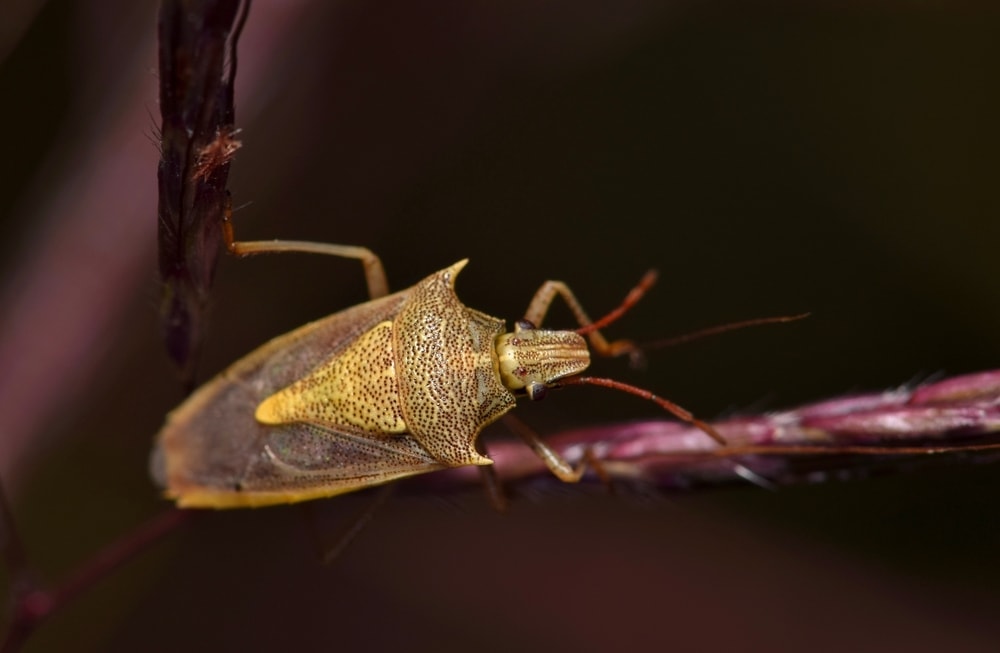
The Rice Stink Bug is a flying shield bug that is native to North America. It’s one of the most destructive agricultural pests in the Southern United States. They have a narrow body. Their coloration is straw-colored with tiny pinpricks of black spots across their exoskeleton.
The Rice Stink Bug is such a damaging pest in the South. They feed on the rice crops grown across the Rice Belt in Arkansas, Texas, and Mississippi. It attacks more than rice as well. It focuses on cereal crops that have small seeds, including sorghum and wheat.
6.4.5 Black Stink Bug (Proxys punctulatus)
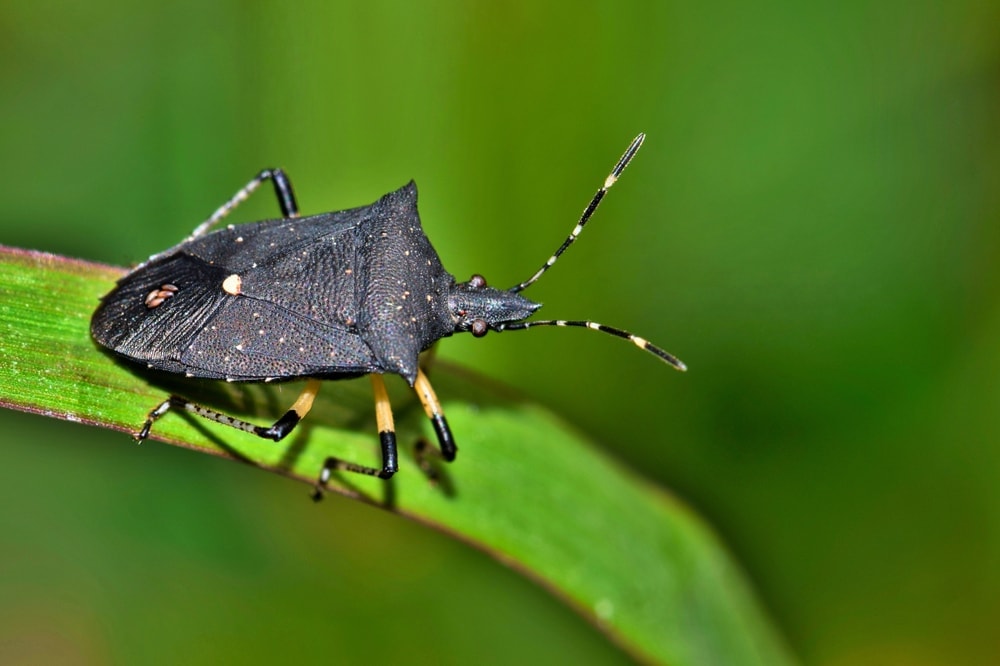
The Black Stink Bug has quite a self-explanatory name for a species of stink bug. They live in Central America, North America, and the Caribbean Sea. They aren’t very well known since they aren’t as destructive as some of the other stink bugs. They’re all black with a white spot in the center of their backs.
6.5 Catacanthus
The Catacanthus genus lives throughout Asia. Their genus name means “downward-pointing thorns.” There is only one species of note within this genus. There are 15 species under the genus in total.
6.5.1 Man-Faced Stink Bug (Catacanthus incarnatus)
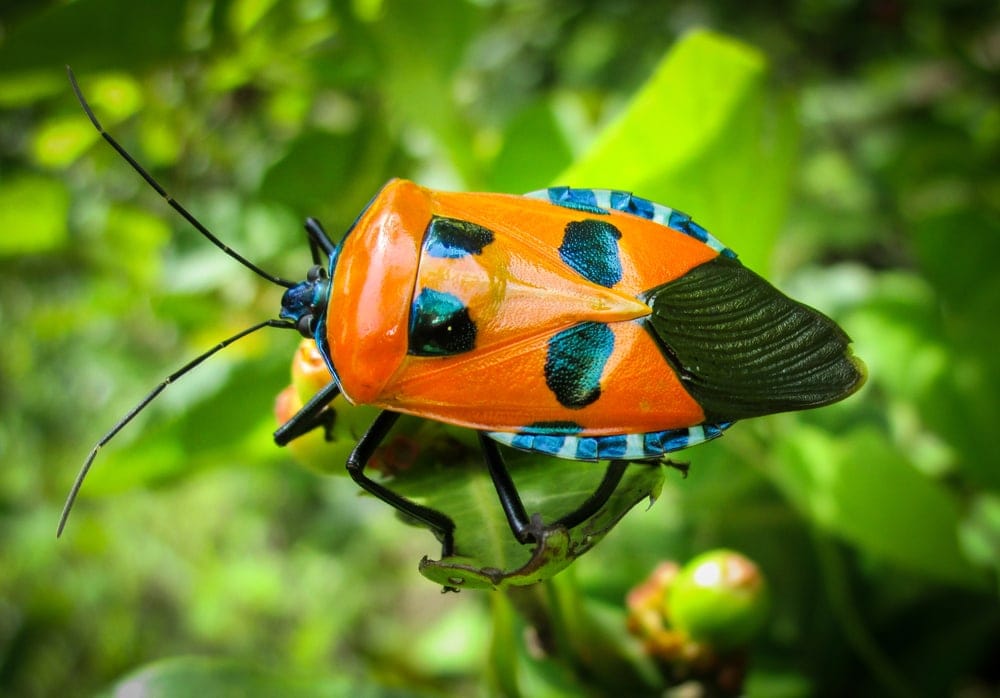
The Man-Faced Stink Bug is yet another identified by its colors and patterns. The bright reds, oranges, yellows, and creams form a bizarre face on the back of their shells. These bright colors help tell predators that they’re either poisonous or do not taste very good.
The Man-Faced Stink bug is a notorious pest. They target fruit and the tender new shoots that allow them to grow. They feed on agricultural crops such as cashew trees, soybeans, cotton, corn. They’re often resistant to pesticides. The insects live in Asia, but there have been some spotted in North America.
6.6 Eysarcoris
Eysarcoris is a shield bug that belongs to Pentatominae. There are ten species of Eysarcoris stink bugs. Only one has received more scientific recognition.
6.6.1 Woundwort Shieldbug (Eysarcoris venustissimus / Stagonomus venustissimus)
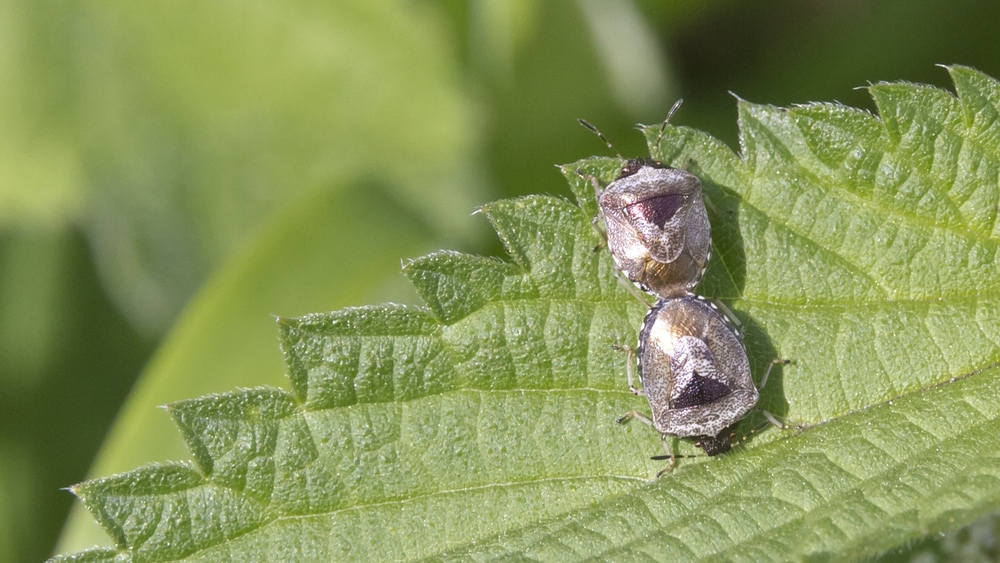
The Woundwort Shieldbug has received a couple of different reclassifications. They live throughout Europe. They have a greenish-grey body with a triangular bronze-purple strain on their scutellum.
These aren’t harsh agricultural pests since they feed on hedge seeds and white dead-nettle.
6.7 Halyini Tribe
The Halyini Tribe encompasses quite a few species and genera. There aren’t many of these that are well-recognized. One of the most significant genera in this species is the Brochymena. They’re rough stink bugs because of the texture across their exoskeleton. Because of this, they’re also confused with the Brown Marmorated Stink Bug.
6.7.1 Four-Humped Stink Bug (Brochymena quadripustulata)
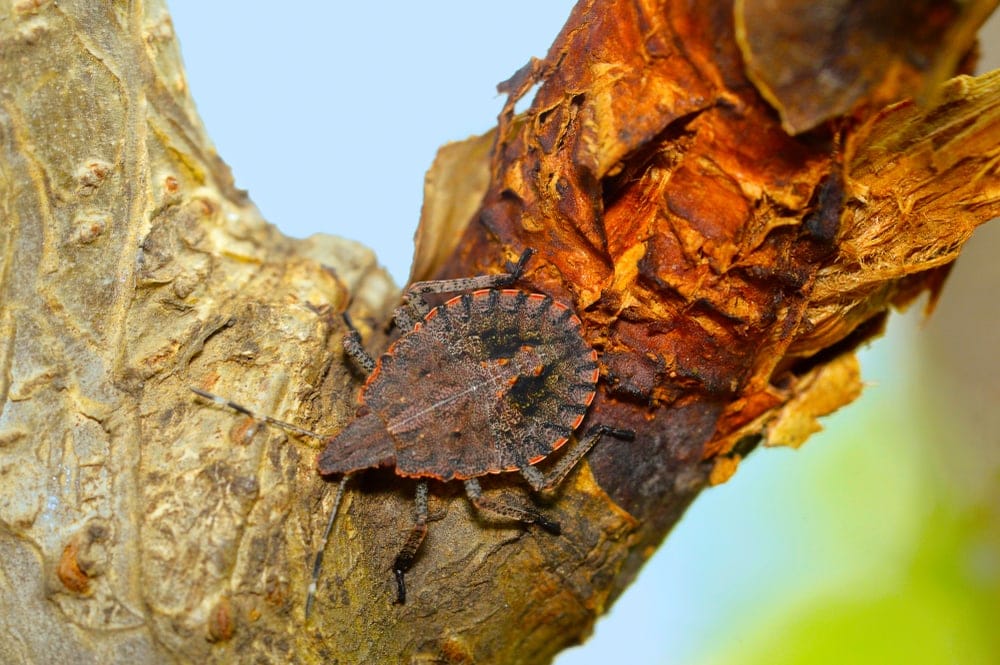
The Four-humped stink bug. They have an earthy brown color across their head, legs, and scutellum. Stripes and orange spots set it apart from the Brown Marmorated Stink Bug.
This bug lives in Central America, Africa, North America, and Oceania. It has one of the broadest global ranges.
6.8 Palomena
The Palomena genus of shield bugs falls under the tribe Nezarini. Most of these insects live in Asia and Europe. Only a handful of them came to North America by accident.
6.8.1 Green Shield Bug (Palomena prasina)
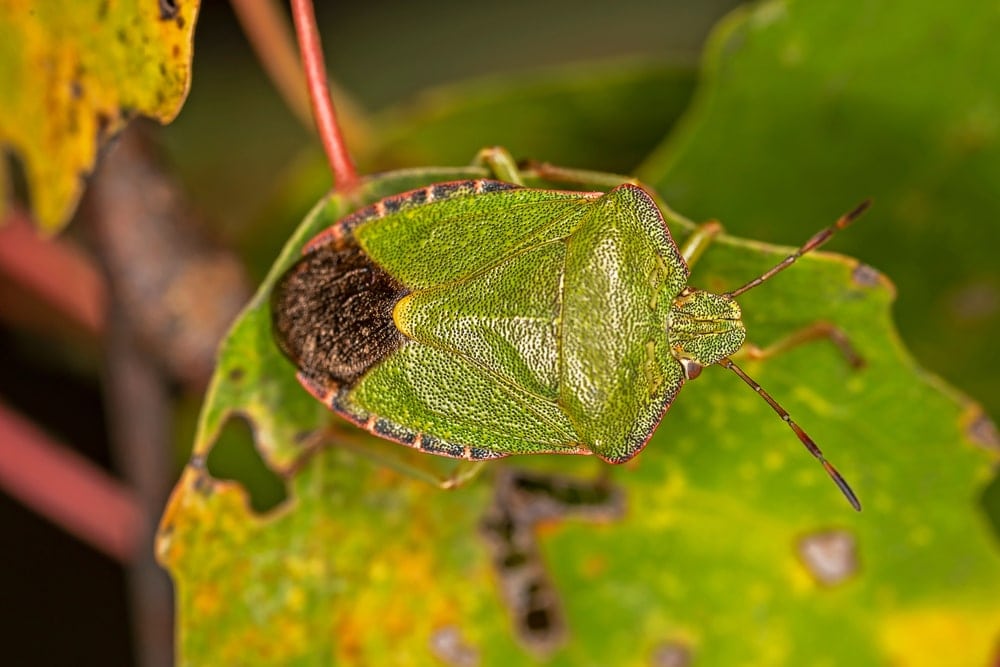
The Green Shield Bug is, in fact, dark forest green with leathery black wings and yellow-white bands on the outside of their exoskeleton. They’re a North American bug and are very common throughout Europe as well. The green on their shell can range from metallic bronze to a bright green. They tend to lay bright green eggs in a tightly packed hexagonal pattern.
6.9 Pentatoma
The Pentatoma genus contains nine species of stink bugs. The most common one is the Forest Bug.
6.9.1 Forest Bug (Pentatoma rufipes)
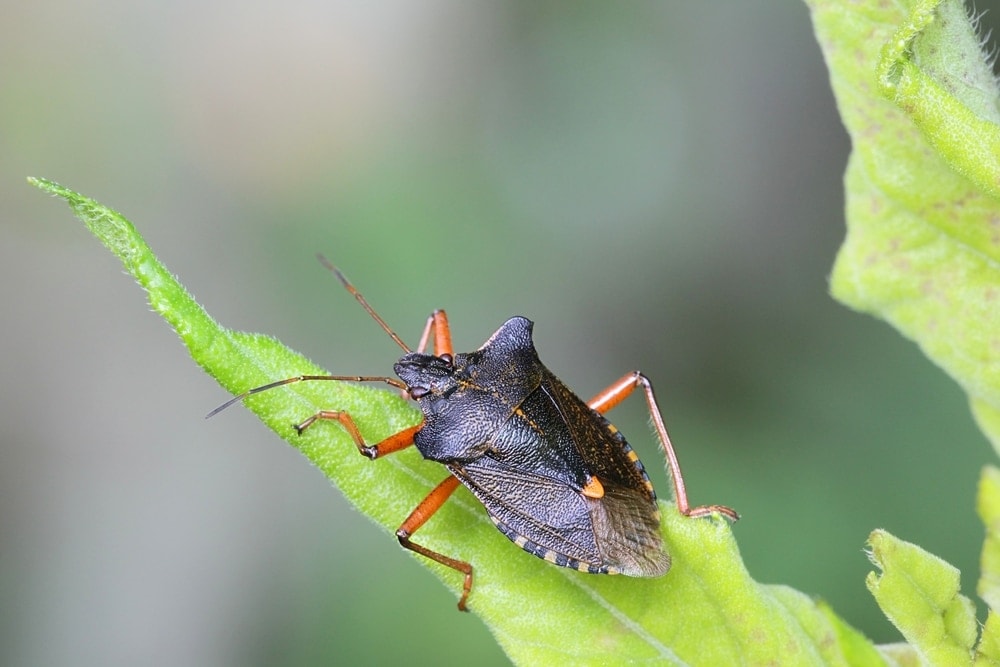
The Forest Bug lives throughout most of Europe. As its name suggests, they live in woodlands, forests, gardens, and orchards. Another name is the “red-legged shieldbug.” It describes the bright red legs that help characterize them.
These bugs are polyphagous, meaning they eat plants. They feed on the sap in trees, although they will eat other insects like caterpillars every once in a while. They prefer oaks but can also feed on hazel, alder, and fruit-bearing apple and cherry trees.
6.10 Eurydema
There are more than a dozen species that fall under the genus Eurydema. Only two of these are well-recognized. They have done enough damage to make a name for themselves and their genus.
6.10.1 Cabbage Bug (Eurydema oleracea)
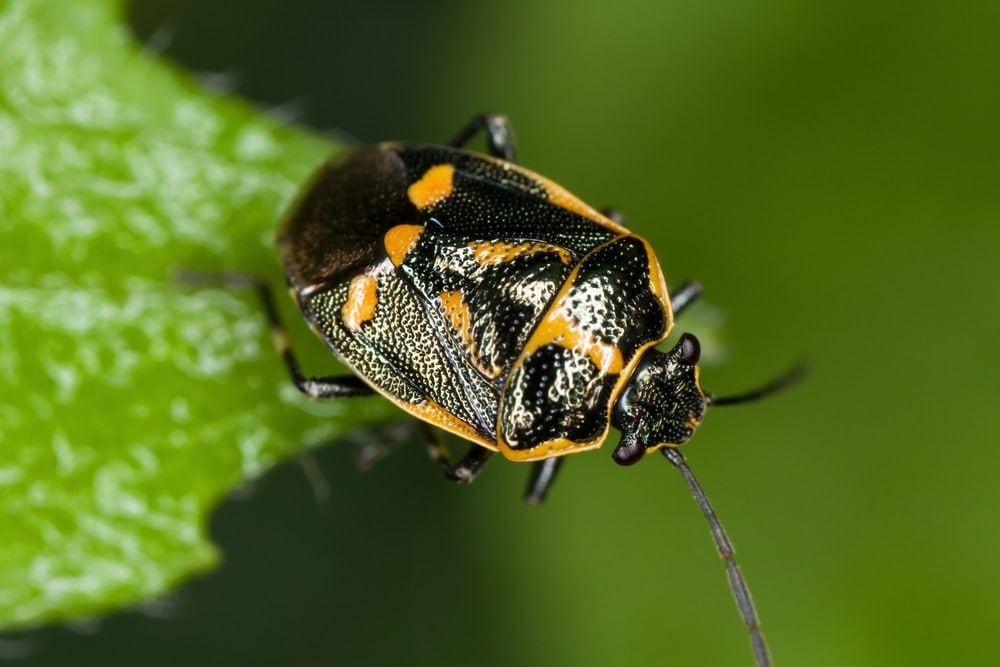
The Cabbage Bug, Rape Bug, or Crucifer Shield Bug is a ubiquitous and damaging insect. Even their Latin name refers to their ravenous diet for agricultural crops. It means “related to herbs or vegetables.”
These insects love to eat almost any kind of leafy plant. Farmers can control them using crop rotation and natural enemies like parasitoid wasps. The Cabbage Bug lives across most of North Africa, Russia, and Western Europe.
6.10.2 Eurydema ornata
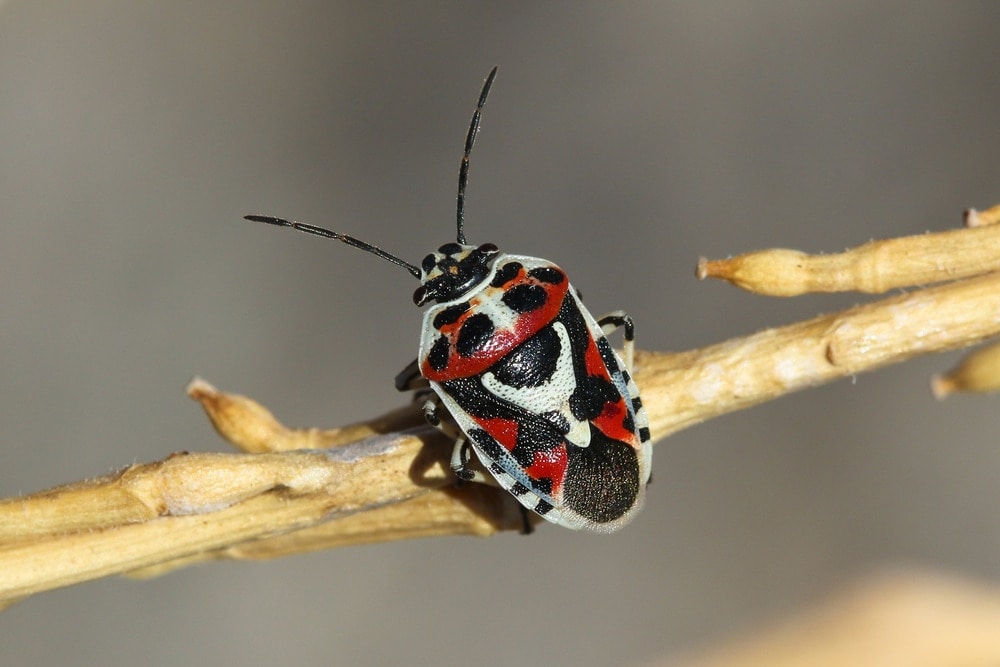
The E. ornata might be beautiful, but it isn’t a bug you want to have around. They have distinctive colorful patterns that play across their scutellum and heads. They’re a greedy parasite, damaging crops of crucifers until there is nothing left.
These prefer to live in open areas that only host low-growing vegetation. They live throughout North Africa, Asia, and Europe.
7.0 Phyllocephalinae
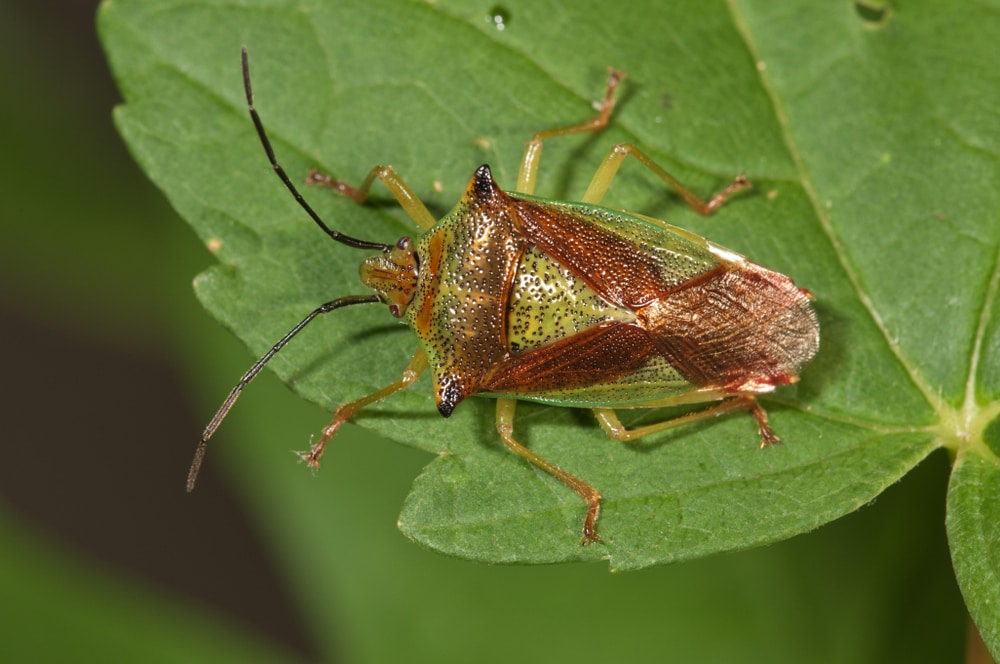
Phyllocephalinae stink bugs have only recently received more concentrated study and classification. They live across the African content and some throughout India. There are four main tribes of the Phyllocephalinae stink bugs, including:
- Cressonini
- Megarrhamphini
- Phyllocephalini
- Tetrodini
Under each of these are anywhere from three to twenty various genera of stink bugs. Some of these live in North America. None of them have a remarkable impact on agricultural production or biological pest control. That means there is very little research on them.
8.0 Podopinae
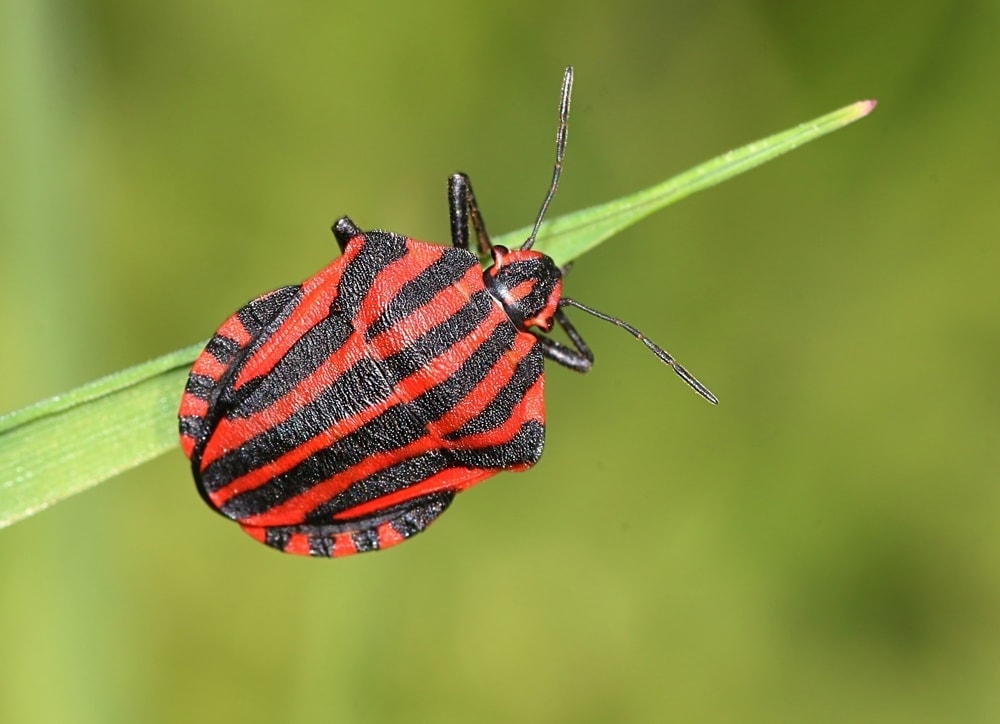
The Podopinae family is one of the smaller and prettier subfamilies of stink bugs. Those genera that fall under this species are also known as turtle bugs.
Genera of the Podopinae Subfamily
The Podopinae subfamily only contains six genera and 13 species of stink bugs. Only some of them are common, and none of them are pervasive.
- Allopodops
- Amaurochrous
- Neapodops
- Notopodops
- Oncozygia
- Weda
9.0 Serbaninae

The Serbaninae subfamily is rather unique. It only contains a single species, and the species only has a few known specimens. The species is Serbana borneensis and is a modified specimen within the entire Superfamily. They live in Malaysia and Borneo.
This tiny insect appears to look like a piece of lichen on trees. They have a dirty brown exoskeleton. The edges are irregular with rippled edges like how lichen grows.
10.0 Stirotarsinae
Stirotarsinae is a new subfamily. They were recently reclassified in the early 2000s for a monotypic genus. There is only a single species, the Stirotarsus bergroth. This species only lives in Peru and is quite a site-specific bug, unknown to date.
You may also like: 29 Lovely and Colorful Butterfly Species with Pictures, Facts, Classification and More!
Fun Facts About the Stink Bug
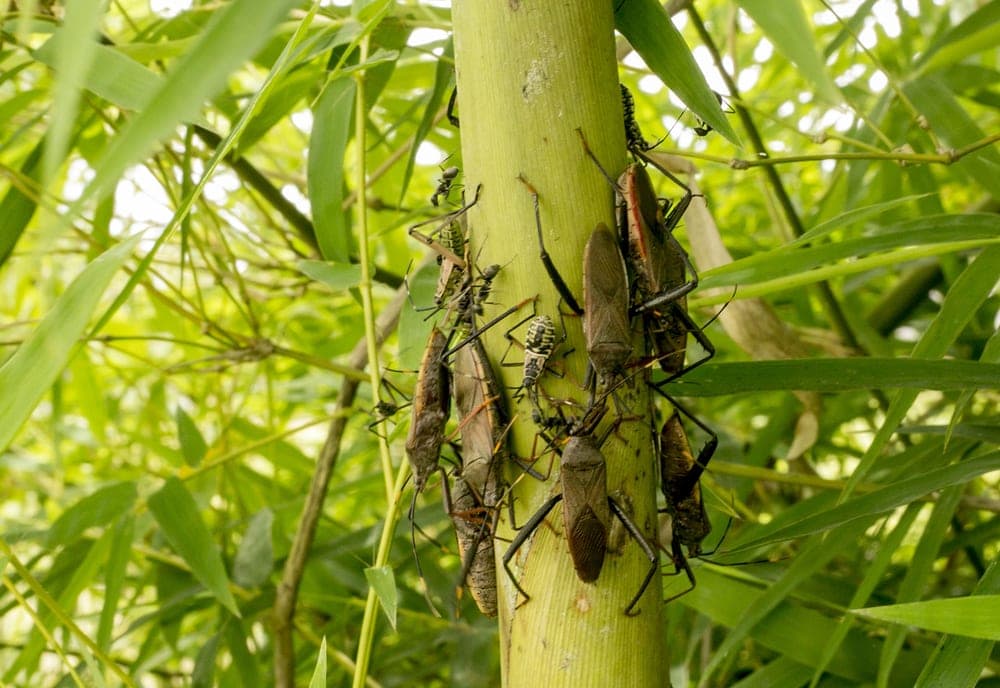
1|Stink bugs stinks.
Stink bugs release their foul odors if they feel like they’re in danger. Their bodies don’t have a natural stink.
To get the smell they want, they produce a concoction of chemical compounds. The smell starts in their scent glands. Then, the chemical cocktail exits through holes all around the body. It can shoot several inches, so watch out!
It is common for humans to have allergic reactions to stink bug spray. If your skin comes into contact with it, you might feel a burning sensation. Observe this and go to your doctor if it doesn’t go away or other symptoms occur.
2|Stink bugs can bite pretty hard.
You might think that the stink bug’s stink would be enough to protect it. Unfortunately for them, that’s not the case. Unfortunately for us, they can bite quite hard. Although it might sting for a moment, it’s an allergic reaction to their spray that you should still feel more worried about.
3|Stink bugs are “true insects.”
Not all insects are bugs, yet all bugs are insects. Have you ever given much thought to that anomaly?
Stink bugs are true insects. You can call them both “insects” and “bugs” and still be accurate. The primary difference between insects and bugs is that true insects suck juices from plants and animals.
True insects have a specialized mouthpart called a proboscis. They use this to pierce plants to feed. There are other physical differences, but this is the primary one.










